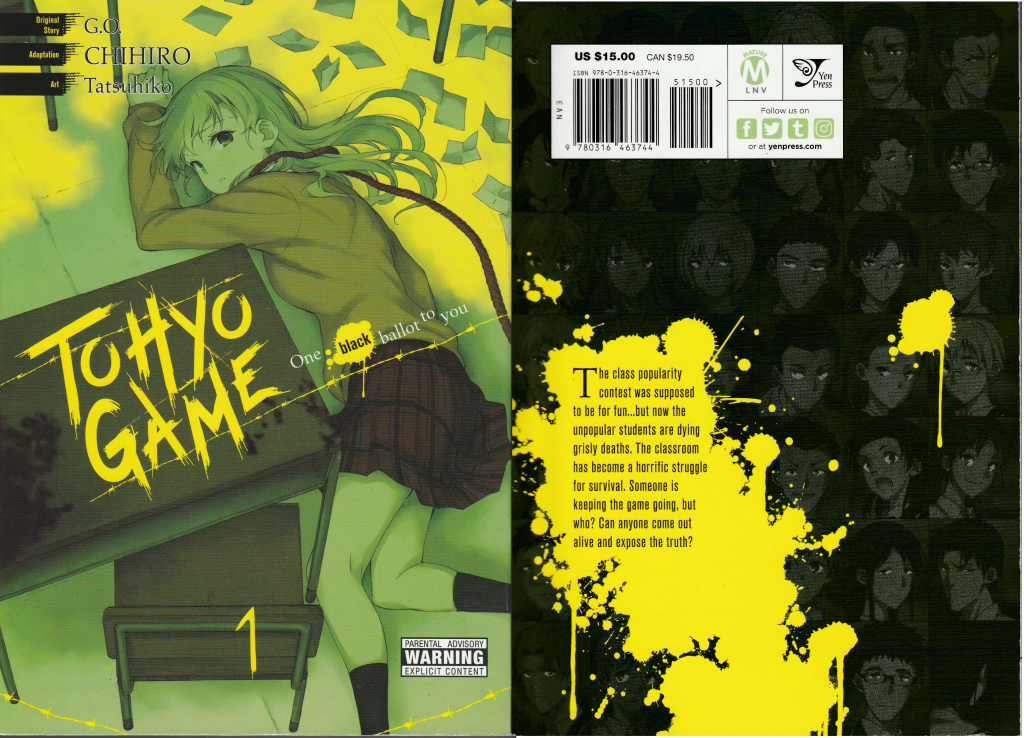





****
Tohyo Game: Anata Ni Kuroki Ippyou Wo (or “Tohyo Game: One Black Ballot to You” in English) is a mystery horror manga by G.O., CHIHIRO and Tatsuhiko. It was serialized in the Seinen Monthly, Big Gangan. Yen Press published its 3 volume western run in 2016.

G.O./CHIHIRO/Tatsuhiko – G.O. is credited with the original story, CHIHIRO with adaptational work and Tatsuhiko with the artwork. CHIHIRO, many of you will recognize from the Corpse Party manga. Being the pleb that I am, I haven’t read the manga or played the games, but my passing exposure to the series has made me aware of its’ committent to over the top deaths and gore.
Violence In The Classroom – The scene the cover depicts is a close up shot of a student in a classroom. She’s lying on the floor next to a blood covered desk. She has a loose rope around her neck and paper slips (Ballots, I presume, in keeping with the theme) on the floor near her. it’s actually a collage of disparate elements of the voting game and its deadly consequences on the students. While you won’t know that these are disparate things for a while, they still convey the general gist of the story – school has become a deadly threat for its inhabitants. The only problem is that it runs the risk of giving the audience the wrong idea of what’s threatening the students.
Tohyo Game – The title is stylized to be written in rough paint strokes and framed with barbed wire. It’s prison immagery. This is part of what I was referring to by “giving the audience the wrong idea”. While their problems do start in a classroom, the students are allowed to leave. It’s just that the weight of it follows them home,
almost as if they aren’t allowed to leave. Therefore, their captivity is more mental than literal.
Things are off to a rough start for Shuusuke. He’s already made a fool himself for the second year in a row in front of the class. With perfect timing, his best friend, Kazuto then starts a popularity poll. While a few students expect to score poorly, no one expects to lose their lives. As the losers start finding themselves among the growing body count, and in some rather gory ways to boot, class 2A scrambles to figure out why the game is happening and what can be done done to prevent more death.
Lets get this out of the way, there are 20 boys and 19 girls in class 2A. We don’t know them all and the lion’s share of them are identified upon voting and/or their demise. With that said….
Shuusuke Takayama – Protagonist of the story. Transferred to Fuji High last year. Earnest and caring, he tries to hold things together when things get out of control.
Wakaba Ootsuki – Childhood friend of Kazuto and recent friend of Shuusuke. Caring, but a bit of a busybody.
Kazuto Satou – All around joker. He’s the one that started the original popularity poll. Like Wakaba, he’s a little excessive in his antics. Whereas she expresses this in calling attention to things people would rather she not, Kazuto goes a little too far with his jokes – especially in relation to Wakaba herself.
I said before that the manga ran the risk of fostering the wrong impression about the nature of the threat – and after some reading, I think it might be intentional. The initial impression is that this is going to be a new age Battle Royale. The ambiguity of the first few deaths don’t help. In actuality, Tohyo Game is more Final Destination.
At first I was a little miffed because all roads seemed to point to the former. But I can appreciate the result nonetheless. When Final Destination dropped in 2000, it made some waves since it takes the slasher formula, but forgoes the standard slasher antagonist. Sure, that means you don’t have to conceptualize said antagonist so more killing – but more importantly, it also means that there isn’t a 2nd act paradigm shift to ground and demystify them either. In both properties, the threat is just as scary at the end as it was at the beginning. When the threat is a literal force to be reckoned with, it can’t be bargained with, shot or locked up and even if it isn’ quite omnipotent, it’s functionally omnipresent.
The best part of Tohyo Game is Shuusuke. He doesn’t seem like that big a deal at the beginning of the story, but he stays levelheaded and steps up in a reasonable manner when things get bad. Most surprising though, is that he doesn’t let anyone off the hook in regards to culpability for this. This isn’t like Carrie where it’s the students that corrupt an innocent institution but rather, an innocent institution (there’s one hell of a gut punch lather that recontectualizes the whole popularity contest) corrupted by an outside force. But as far as Shuusuke is concerned, they still contributed in some way and he feels genuine reget over it. While I don’t quite agree I must admit that that’s an admirable sense of responsibility.
If there’s a weak spot in Tohyo Game, it’s the class over all. Returning to Final Destination, we see a rather unavoidable problem – you really can’t use a class as your cast without saddling yourself with a ton of characters. A typical class can have 30 or so students – or in other words, too many characters to introduce, much less keep track of, at once. Final Destination avoids this by just blowing up a majority of the class at the beginning. What we get, as a result, is a more intimate view of the horror as we get a handful of individuals that we get to spend more time with as the story progresses. With Tohyo Game, not so much. The concept is there, but there’s still just way too many students for us to care much about them individually or even get a more detailed look at how they died. Furthermore, there doesn’t seem to be much rhyme or reason to how these students are dying. The saving grace here is that we do follow a few of the students more closely than the rest, so while we may not be all that invested in the rest of the class’s survival, we ARE invested in Shuusuke and the lot’s success – which is practically the same thing. We also curiously start getting a new tid bit of info about newly deceased students in the second half that might provide some insight into the methodology around their deaths.
I know it feels unfair to compare Tohyo Game to Final Destination so much, but I do so out of love. It’s the best incarnation of its concept I’ve presently seen and does somethings that work well – things that Tohyo Game would do well to emulate, and still can in future installments. But no matter how much Final Destination there is in Tohyo Game there’s also some Battle Royale in there too – and, considering the latest development in the game, there’s likely to be even more it. That’s really encouraging, as it has the chance to become an unique combination of the two.
The intrigue, suspense and, dare say, catharsis of properties like these are watching the characters analyze and resist that which threatens them. Tohyo Game has enough of that to be interesting throughout despite it being stretched a little thin by the sheer number of students. That means it’s a foregone conclusion that it will have the space to give us more and more of what we love as it continues.
Continue?:



